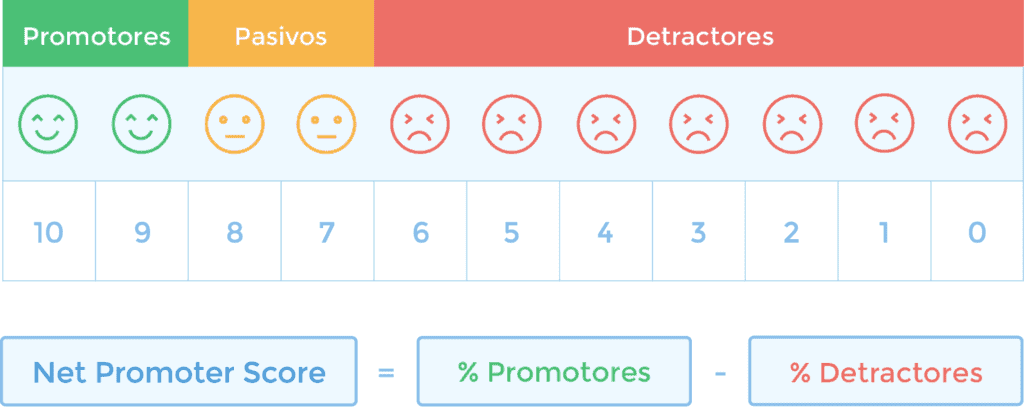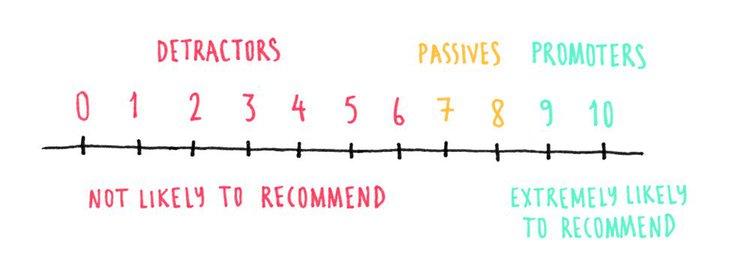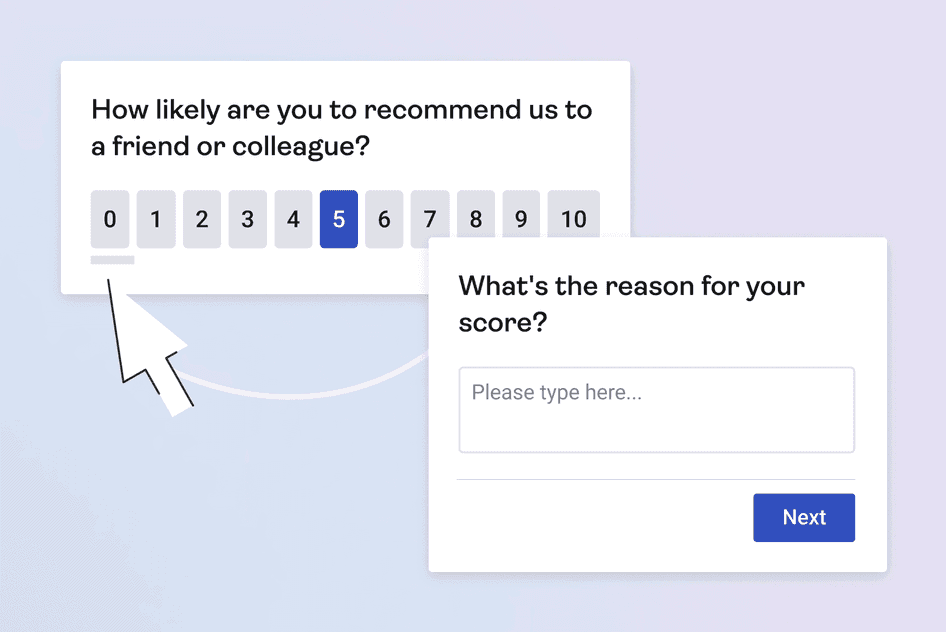The Net Promoter Score (NPS) is a way of assessing customer loyalty and satisfaction by asking them if they would recommend your product or service to others, rating it on a scale of 0 to 10. In this article we will show you all the details you need to know about using NPS to benefit your business.
1. What is Net Promoter Score?
The Net Promoter Score (NPS) is a measure used to evaluate customer loyalty, satisfaction and enthusiasm towards a company. It is calculated by asking customers a question: “On a scale of 0 to 10, how likely are you to recommend this product/company to a friend or colleague?”. Aggregate NPS scores help companies improve service, customer service, delivery, and other aspects to increase customer loyalty.
As a business metric, NPS helps companies of all sizes focus on a critical objective (increasing their score by gaining more enthusiastic customers) that can be easily tracked and quantified over time.
2. Why is NPS important?
Net Promoter Score (NPS) can predict business growth. When a company’s NPS is high, or at least above the industry average, it indicates a healthy relationship with customers who are likely to become brand advocates, promote word of mouth and contribute to a positive growth cycle.
NPS is a valuable strategic metric, but on its own it is not enough to be useful or to have a complete picture. The complete NPS system is important because it allows companies to:
- Ask follow-up questions as part of the standard NPS survey. By asking customers why they gave a specific score, organizations of any size can understand their strengths and areas for improvement.
- Track and quantify the score over time, creating internal benchmarks.
- Unite all employees around a critical goal: winning more enthusiastic customers.
Read more about: Why is customer experience important?
3. How to calculate Net Promoter Score
To calculate the NPS, subtract the percentage of customers who respond with a 6 or less (known as “detractors”) from the percentage of customers who respond with a 9 or 10 (known as “promoters”).

3.1. NPS scale: detractors, passives, promoters
In the Net Promoter system, customers are divided into three groups (promoters, detractors and passives) according to their response to the standard question “How likely are you to recommend us?”:
- Promoters (scores of 9 and 10) are a company’s most enthusiastic and loyal customers. They are likely to act as brand ambassadors, enhance the brand’s reputation and generate referrals that drive the company’s growth.
- Detractors (score 0 to 6, inclusive) are those who are unlikely to recommend a company or product to others. They are not likely to be repeat customers and, worse, may actively discourage potential customers from doing business with the company.
- Passives (score of 7 or 8) do not actively recommend the brand, but they are not likely to harm it with negative comments either. Although not included in the NPS calculation, passives are close to becoming promoters (especially when they give a score of 8), so it makes strategic sense to spend time researching how to win them over.

In the Net Promoter system, average scores vary widely across industries:
- A 2018 U.S. study by the Temkin Group observed average NPS values ranging from 0 (Internet and TV service providers) to 39 (auto dealers);
- Another 2018 U.S. study by the Temkin Group found NPS averages ranging from -1 (internet service providers) to 65 (department/specialty stores).
4. What is a good NPS score?
Considering the available score range of -100 to +100, any score above 0 is considered “good,” as it indicates that a company has more promoters than detractors.
Top-tier companies typically have an NPS of 70 or higher. However, if you think this is only achieved by large global companies, it’s not what it seems. In 2018, Netflix had an NPS of 64, PayPal scored 63, Amazon 54, Google 53 and Apple 49, with a score below what you would believe to be an “Excellent” are still companies that many people continue to recommend.
A perfect score of 100 would indicate that all respondents would recommend the company to others, but so far no one has managed to achieve this score.
5. What is a bad NPS score?
Any score below 0 indicates that a business has more detractors than promoters. This is where industry benchmarks on NPS, such as those mentioned above, come in handy. While an NPS score of -3 might seem bad on its own, it is difficult to interpret without comparing it to the scores of other key industry players. If the industry average were -10, suddenly the score wouldn’t look so bad.
That said, even if the bar is low, a negative NPS is a sign that a company has a lot of work to do to improve the situation, reduce the number of dissatisfied customers and generate more promoters.
6. How to survey and collect NPS feedback
If you are interested in calculating and monitoring NPS for your business, the first step is to conduct an NPS survey to collect customer feedback. You have two main options for doing this, depending on whether you want to solicit feedback at the time or collect it at some point after the customer’s experience with your company.
6.1. Web site survey
On-page or website pop-up surveys allow you to capture feedback from your customers while they are still on your site. You can set up the NPS survey to appear on your main conversion pages, such as the thank you page people see after completing a purchase, or trigger an exit survey just before people leave the website.
To conduct this survey, you would begin by asking the standard NPS question, “On a scale of 0 to 10, how likely are you to recommend [company] to a friend or colleague?” To get the maximum value, you should always follow it up with one or two additional questions:
- If the customer chooses a number between 0 and 8 (detractors or passive), apologize for the negative experience and ask, “What can we do to improve your score?”
- If they choose a 9 or 10 (promoters), follow up enthusiastically and probe further by asking, “What is the main reason for your score?”
You can even add an optional third question for people to share their thoughts on what else you should be doing.

6.2. E-mail survey
Instead of displaying a pop-up window on the website, you have the option to collect NPS data by sending emails to customers and inviting them to complete a survey after a purchase or key interaction with your business.
Email surveys require a bit more effort on the part of customers, as they must open the email, click on the survey, go to a separate page, complete it and submit it. There is also an obvious time delay between sending the survey and getting the results.
However, on the positive side, by giving your customers time to experience the product or service they received from you (e.g., 15 or 30 days), they may develop an even clearer opinion on whether or not they would recommend it.
7. How to read your Net Promoter Score results
Although the Net Promoter Score measures the likelihood of an action based on experience, it has proven to be a reliable indicator of future business growth or decline. In other words, it helps you identify problems ahead, just as sonar on a ship helps you detect icebergs in time to correct course, both at the individual level and at the overall customer level.
The study conducted by the Temkin group cited above also found a strong correlation between NPS and customer experience: on average, in the United States, “customer experience leaders enjoy an NPS that is 21 points higher than the NPS of customer experience laggards.”
Here’s how to interpret your NPS results after taking the survey and collecting the data.

7.1. Analyzes the different data segments
Your company’s Net Promoter Score (NPS) scores may vary according to different segments (such as age group, gender, long-term customers, high-spending customers, etc.). When starting with NPS, you don’t need to dig that deep: any information collected at this point will help you get a clear picture.
7.2. Continues to monitor performance over time
Since NPS is a real-time metric, you can look at it daily if you wish, but its true power is revealed over time when you can observe trends and fluctuations.
7.3. Closes the cycle
NPS is more than just a number: the real richness lies in the information you gather by asking follow-up questions as part of the survey (and beyond).
It is crucial that you have an underlying methodology for interpreting your NPS score and that you always close the loop with customers to understand the context and reasons behind their score. Using one-on-one interviews, follow-up sessions, etc., helps you focus on specific problems, understand where there is room for improvement and direct your efforts towards a true customer-centric orientation.
We hope this article has helped you clear up some doubts about what Net Promoter Score is and why it is important to perform it in your company.
Remember, to improve your online presence and stand out on Google and Google Maps, having a review and customer experience management strategy can make all the difference. You can count on RAY, a comprehensive solution that can help you improve your Google reviews, rank high in search results and provide an exceptional customer experience.
8. Keep learning with these articles
Hopefully, by now you have a solid understanding of Net Promoter Score, you can continue reading more articles that will help your brand or business in our Blog.
